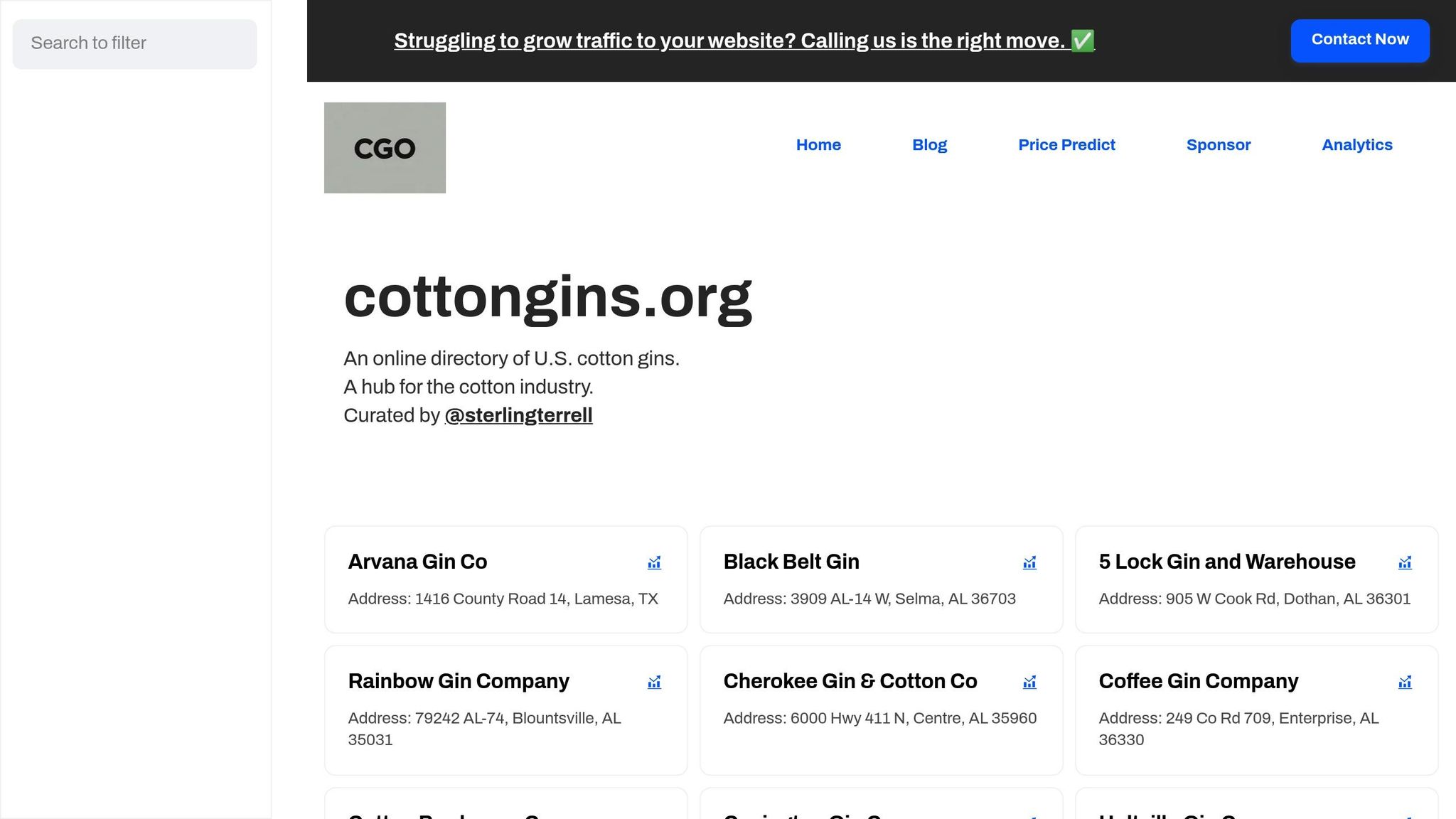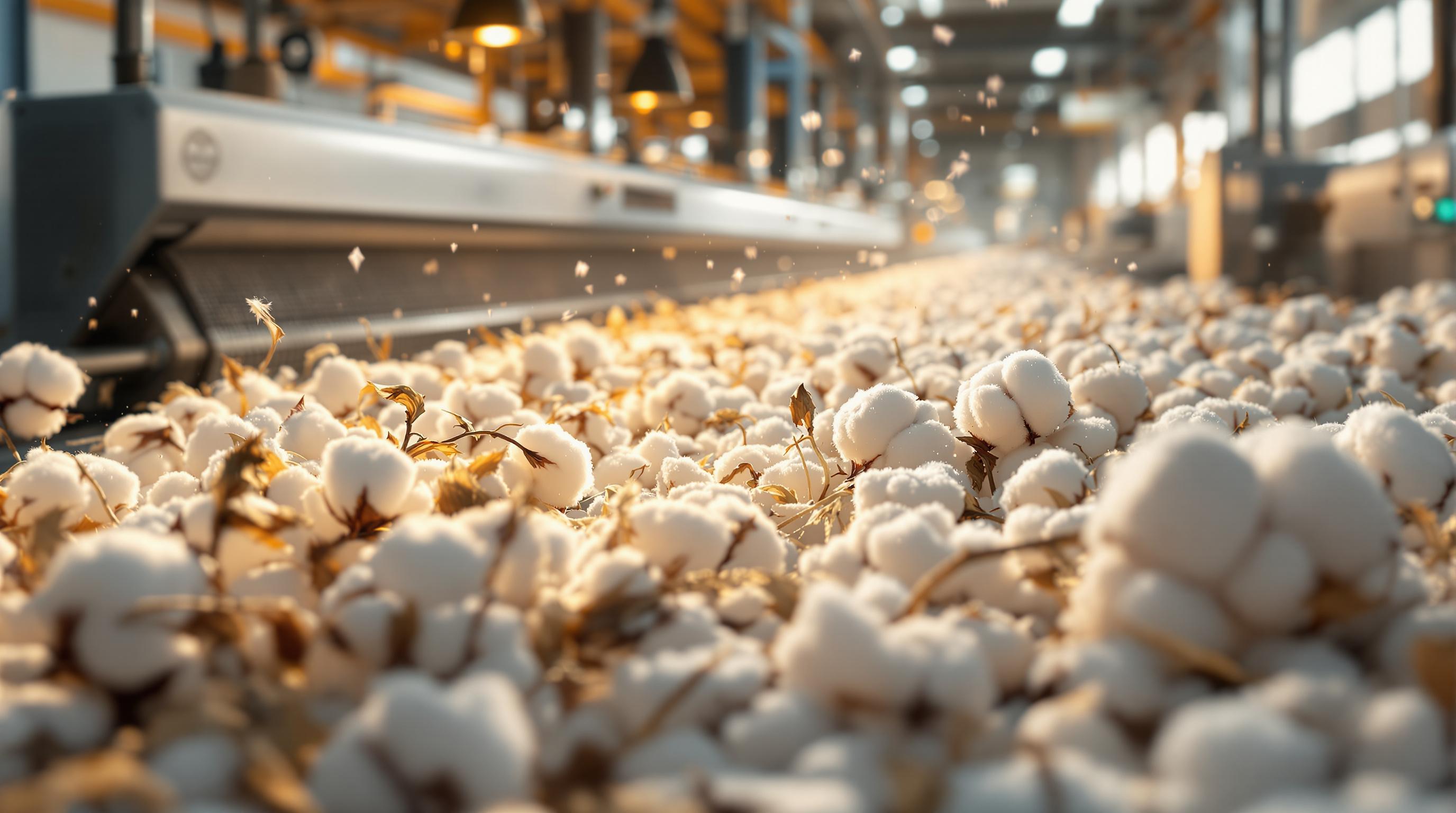The cotton gin manufacturing industry is facing rising costs and operational challenges, driven by energy prices, labor shortages, and supply chain disruptions. Production costs now exceed 75¢ per pound, while farmers earned 64.40¢ per pound for cotton in July 2024. With the market projected to grow from $3.17 billion in 2024 to $3.4 billion in 2025 (a 7.3% increase), operators are under pressure to modernize and improve efficiency. Key trends include:
- Energy Costs: Making up 25% of variable operating expenses, energy pricing varies by region and impacts profit margins.
- Labor and Maintenance: Higher wages, extended operating hours, and advanced equipment require increased investment.
- Technology Adoption: Automation, energy-efficient machinery, and waste reduction methods are helping offset costs.
- Regional Differences: States like California face stricter regulations and higher costs compared to southeastern regions.
Operators are also weighing the trade-offs between saw ginning (faster but more energy-intensive) and roller ginning (slower but better for fiber quality). Consolidation in the industry, with just 509 gins remaining compared to 2,254 in 1980, is reshaping the competitive landscape. Platforms like cottongins.org are aiding operators by providing resources for cost analysis and partnerships.
Investing in smarter equipment, understanding regional cost factors, and leveraging new technologies are critical for staying competitive in this evolving market.
Mali begins construction on a 50,000-ton cotton ginning factory
Current Cost Trends in U.S. Cotton Gin Manufacturing
The latest data for 2024–2025 reveals that production costs in the U.S. cotton gin industry have climbed to concerning levels. Costs now exceed 75¢ per pound, while farmers' average price in July 2024 was 64.40¢ per pound. This growing gap highlights the financial strain on gin operators, as profit margins continue to shrink.
The industry has also seen significant consolidation, which has added to cost pressures. With fewer gins remaining - just 509 active facilities compared to over 2,254 in 1980 - those still operating are processing larger volumes. This has led to longer operating hours and higher energy usage. During the harvest season, energy now makes up approximately 25% of variable operating costs, as mechanical harvesters pick cotton faster than gins can process it. This mismatch creates bottlenecks, forcing gins to run extended hours and consume more power.
Meanwhile, the cotton ginning machinery market is expected to grow from $3.17 billion in 2024 to $3.4 billion in 2025, reflecting a 7.3% increase. This rise in capital costs further underscores the economic and operational challenges currently facing the industry.
Main Economic Factors Affecting Costs
One of the primary drivers of rising costs is cotton price volatility. Fluctuating prices make it difficult for gin operators to plan budgets and schedule equipment investments, often pushing them to find savings elsewhere.
Supply chain disruptions are another significant factor. Longer lead times for replacement parts force operators to either maintain larger inventories or risk costly downtime during peak processing periods. Additionally, uncertainties surrounding tariffs and trade policies add complexity to long-term financial planning.
Weather variability also plays a crucial role. Adverse weather events can damage crops, leading to lower-quality cotton that requires more cleaning and handling. This increases both labor and energy costs, further straining operations.
Cost Differences Across U.S. Regions
Regional factors add another layer of complexity to operational costs. Labor costs, for instance, vary widely. Operators in western states like California face higher wage expenses compared to those in Texas, Georgia, and the southeastern regions.
Energy prices also differ by location. States with deregulated electricity markets often offer more competitive rates, while areas reliant on specific fuel sources may experience sharp seasonal price fluctuations. For high-volume gins, these differences can add thousands of dollars to annual energy expenses.
Regulations also play a key role in regional cost disparities. California, for example, enforces stricter environmental standards, requiring additional compliance measures such as enhanced air quality monitoring and specialized waste disposal. These requirements drive up operating costs compared to states with less rigorous rules.
Industry consolidation further reflects these regional cost dynamics. In May 2024, the Louis Dreyfus Company acquired Namoi Cotton Ltd., a move aimed at improving operational efficiencies and managing cost differences across regions. Transportation costs also vary based on proximity to major cotton markets and export hubs. Gins located near ports often benefit from lower logistics expenses, while those farther inland face higher transportation costs.
What Drives Manufacturing Costs
Understanding what drives manufacturing costs is critical for operators aiming to manage expenses and uncover savings opportunities. The industry faces a mix of rising costs that touch nearly every aspect of operations, making it essential to break down these key cost drivers.
Raw Material and Equipment Costs
Raw materials and equipment play a huge role in shaping manufacturing expenses. As market prices continue to climb, capital investments are feeling the squeeze. For instance, fluctuations in metal prices - like the surge in steel - can significantly raise the cost of essential components such as stands, frames, and processing machinery. Supply chain disruptions have also pushed up the prices of specialized parts, like high-efficiency motors.
On top of that, the industry’s shift toward advanced machinery with features like predictive maintenance and remote monitoring demands higher upfront investments. While these machines are costlier at the start, they often lead to lower long-term operating expenses by improving efficiency and reducing downtime.
Labor and Maintenance Expenses
Labor and maintenance costs are another major factor, influenced heavily by regional differences and the need for specialized skills. With advancements in ginning technology - like DNA traceability systems - operators often need to invest in additional training to keep their workforce up to speed.
Maintenance costs have also risen. Extended operating hours, especially during the harvest season when 24/7 operations are common, put extra strain on equipment. This leads to more frequent repairs and replacements. As fewer operators handle larger processing volumes, both regular wages and overtime costs have increased. These labor and maintenance demands are further amplified by the growing energy requirements of modern operations.
Energy Usage and Cost Impact
Energy expenses have become a significant part of manufacturing costs, especially during peak operation periods. Processes like material handling and fiber separation consume large amounts of energy, making this an area of concern.
Energy pricing varies by region, creating both challenges and advantages. For example, deregulated electricity markets often offer energy costs that are 10–15% lower than regulated ones, giving operators in these areas a competitive edge. However, peak demand periods can lead to hefty utility penalties, driving up monthly bills.
In response, many operators are turning to energy-efficient machinery. While these systems come with higher upfront costs, they can reduce energy consumption by an estimated 15–25% over their lifespan, helping to ease long-term cost pressures.
New Technologies Reducing Costs
The cotton gin manufacturing industry is undergoing a wave of technological advancements that are lowering costs while improving efficiency. As operators face growing financial pressures, these innovations are helping them stay competitive and maintain profitability.
Automation and Smart Manufacturing
Automation is reshaping the way cotton gins function, cutting down labor costs and speeding up production. Tools like robotic bale handling systems and computerized sorting technology minimize the need for manual labor while ensuring faster and more consistent cotton processing. Additionally, smart manufacturing platforms take efficiency a step further by enabling predictive maintenance and remote monitoring. These systems track equipment performance in real time, identifying potential issues before they cause costly downtime - particularly during the critical harvest season.
With these technologies, operators can manage larger workloads with fewer employees, as remote supervision allows managers to oversee multiple operations at once.
Energy-Efficient Machinery
Modern energy-efficient machinery is addressing the challenge of rising energy costs. These machines can reduce energy use by 15–25% over their operational lifespan. By cutting energy consumption, operators not only lower their utility bills but also gain more control over long-term expenses, even as energy prices fluctuate. This focus on energy efficiency often aligns seamlessly with broader waste-reduction efforts.
Waste Reduction and Recycling
Reducing waste is another strategy that benefits both the bottom line and the environment. Advanced fiber extraction methods ensure minimal seed and lint loss, meaning more raw cotton is converted into sellable products. Additionally, recycling cottonseed for uses like animal feed or oil production creates extra revenue streams, helping to offset manufacturing costs while meeting sustainability and regulatory standards.
DNA traceability systems are also becoming popular, allowing operators to verify cotton fiber origins and streamline supply chain processes.
Many operators start by conducting waste audits to pinpoint major areas of material loss. From there, they invest in better fiber separation technologies and collaborate with local recyclers to make use of byproducts. Training staff on effective waste management and regularly tracking metrics ensures these initiatives deliver tangible benefits to both the environment and the business.
| Technology | Cost Impact | Efficiency Impact | Environmental Impact |
|---|---|---|---|
| Automation & Smart Manufacturing | Reduces labor costs | Increases production speed | Moderate (varies by system) |
| Energy-Efficient Machinery | Lowers energy expenses | Improves throughput | Reduces carbon footprint |
| Waste Reduction/Recycling | Cuts disposal costs | Streamlines operations | Enhances sustainability |
sbb-itb-0e617ca
Ginning Technology Comparison: Costs and Performance
Choosing the right ginning technology - saw ginning or roller ginning - can significantly influence costs, efficiency, and fiber quality. Each method caters to different market needs, and understanding their trade-offs is essential for making the best decision for your operation.
Saw Ginning vs. Roller Ginning
Saw ginning is widely used in the U.S., particularly for processing Upland cotton, which dominates domestic production. This method relies on circular saws to separate fibers from seeds, making it highly efficient for large-scale operations. In contrast, roller ginning uses rotating rollers and stationary knives for a gentler separation process, making it ideal for premium cotton types like Pima and extra-long staple varieties.
When it comes to speed, saw gins process 30–50 bales per hour, far outpacing roller gins, which handle just 4–8 bales per hour. This speed advantage explains the higher initial costs associated with saw ginning equipment. However, saw gins require more maintenance and larger crews due to their complex saw-and-brush systems. Roller gins, with simpler designs, are easier to maintain and need fewer workers.
Energy consumption is another key difference. Saw gins use more energy per bale, increasing operating costs. Roller gins, while slower, are more energy-efficient on a per-bale basis. These factors are critical when evaluating long-term operational expenses.
Fiber quality is where roller ginning shines. Its gentler process results in superior fiber with minimal damage, making it the preferred choice for premium markets. Saw gins, while efficient, can lead to more fiber breakage and shorter fibers. That said, advancements in saw gin technology have mitigated some of these issues.
| Feature | Saw Ginning | Roller Ginning |
|---|---|---|
| Processing Speed | 30–50 bales/hour | 4–8 bales/hour |
| Initial Investment | Higher | Lower (per unit) |
| Maintenance Frequency | High (saws, brushes) | Moderate (rollers, knives) |
| Labor Requirements | Higher (large crews) | Lower (small teams) |
| Energy Consumption | Higher (per bale) | Lower (per bale) |
| Fiber Quality | Good, some breakage | Excellent, minimal damage |
| Contamination Risk | Moderate | Low |
| Best Application | Upland cotton, high volume | Pima/long-staple, specialty |
Contamination control is another factor to consider. Saw ginning’s high speeds and mechanical intensity can increase the risk of contamination. Roller ginning, with its gentler handling, typically achieves lower contamination rates, which is critical for markets where fiber quality drives higher prices.
Ultimately, the choice between these technologies depends on the type of cotton you process and your market goals. For large-scale operations focused on Upland cotton, saw ginning offers unmatched throughput. On the other hand, producers targeting premium, long-staple varieties may find roller ginning’s superior fiber quality worth the slower processing speeds. By aligning your technology choice with your crop and market demands, you can better manage costs and improve long-term profitability in cotton ginning. With rising production expenses, understanding these trade-offs is key to making informed investment decisions.
Future Trends and Business Opportunities
The cotton industry, while grappling with rising costs, is also seeing new growth avenues fueled by automation, evolving consumer demands, and a shift toward premium markets. Advanced technologies are playing a key role in transforming production methods and opening up fresh opportunities.
New Manufacturing Trends
AI and predictive maintenance are revolutionizing cotton gin operations. These systems allow for real-time process adjustments and remote monitoring, helping operators detect potential equipment issues before they escalate. This proactive approach minimizes unexpected downtime, reduces repair expenses, and boosts overall efficiency and profitability.
The rising preference for organic and traceable cotton is carving out new premium market segments. DNA traceability systems are increasingly being integrated into cotton gins, ensuring complete transparency of cotton's journey from the field to the final product.
Another notable trend is the development of multi-purpose machinery. These machines are designed to process various cotton types and even specialty crops, giving operators greater flexibility. By accommodating changing crop patterns, this equipment helps maximize returns on investment.
Industry consolidation is reshaping the competitive landscape as companies merge ginning and marketing services. This integration strengthens market positioning and lowers operational expenses.
Energy efficiency is becoming a top priority due to rising utility costs and stricter environmental regulations. Manufacturers are focusing on machinery that consumes less energy per bale while maintaining high processing quality and speed.
Research and Development Focus Areas
Research and development efforts are addressing specific challenges faced by smaller operations and supply chain vulnerabilities. One key focus is affordable automation for small and mid-sized producers. While larger operations can afford advanced systems, smaller gins require cost-effective solutions that deliver measurable efficiency gains without hefty investments.
Supply chain resilience has become a pressing issue, following disruptions caused by trade conflicts and climate events. To tackle this, manufacturers are diversifying their suppliers, strengthening local sourcing capabilities, and creating flexible production systems to cut costs and improve reliability.
Fiber recycling and waste reduction technologies are also gaining traction. These innovations not only lower operational costs but also help operators comply with stricter environmental standards by recovering and reusing cotton waste that was previously discarded.
IoT sensors and digital supply chain tools are being adopted to improve process control, enhance quality management, and respond more effectively to market changes.
For businesses aiming to tap into these trends, cottongins.org offers a valuable resource. This platform provides a detailed directory of U.S. cotton gins, helping manufacturers and service providers connect with potential customers, monitor regional trends, and engage with industry players across different areas.
How cottongins.org Supports the Cotton Industry

As manufacturing costs climb and technology evolves, cottongins.org acts as a vital hub, connecting stakeholders across the U.S. cotton industry. This platform plays a key role in helping users track costs and stay updated on technological advancements, as discussed earlier.
The site features a detailed directory of cotton gins across 17 states, covering major production areas like Texas, Georgia, Arkansas, California, and Mississippi. Each listing includes essential details like the gin's name and address, making it easier for manufacturers and service providers to pinpoint potential partners or customers in specific regions. This targeted approach streamlines cost analysis and fosters collaboration.
For gin operators, cottongins.org offers a handy "Submit A Gin" feature, allowing facilities to add themselves to the directory at no charge. This self-service tool ensures the directory remains current while giving both new and established operations a chance to boost their visibility. By doing so, operators can better manage costs and stay connected within the industry.
The platform also provides sponsorship opportunities tailored to different marketing needs and budgets. Here's a breakdown of the available options:
| Sponsorship Type | Monthly Cost | Key Benefits |
|---|---|---|
| Sponsored Post | $200 per post | Top placement for one day, social media promotion, permanent archive |
| Official Sponsor | $200/month | Logo in footer, backlink, one free sponsored post with an annual commitment |
| Featured Sponsor | $400/month | Premium site placement, footer logo, two free sponsored posts annually |
These sponsorships are designed to help equipment manufacturers, service providers, and tech companies directly reach gin operators and decision-makers. With integrated social media promotion, sponsors can highlight cost-effective technologies, maintenance solutions, or new equipment to a highly targeted audience.
Additionally, the directory serves as a tool for analyzing geographic and operational trends. By mapping gin density, users can assess regional cost factors, transportation logistics, and broader market dynamics. This adds another layer of insight to the earlier discussion on cost drivers and regional influences in manufacturing.
Finally, the platform’s mailing list keeps industry professionals in the loop with updates and news, fostering stronger communication between service providers and gin operators. It’s a simple but effective way to stay connected in an ever-evolving industry.
Conclusion: Main Points on Cost Trends and Manufacturing Changes
The cotton gin manufacturing industry is navigating a pivotal moment, balancing growth opportunities with notable challenges. The market is expected to grow from $3.17 billion in 2024 to $3.4 billion in 2025, reflecting a 7.3% compound annual growth rate. However, this growth comes alongside significant consolidation, with the number of facilities shrinking from 2,254 to just 509 - a dramatic shift in the industry's structure. Regional differences in labor and energy costs remain key factors influencing profitability.
Technological advancements are reshaping how the industry approaches costs and operations. For instance, DNA traceability systems are becoming game-changers. Companies like Reinhart, in collaboration with Haelixa, are offering traceable Global Organic Textile Standard–certified cotton from Tanzania. This technology not only ensures transparency for retailers and consumers but also supports premium pricing strategies by verifying the cotton's origin in finished products.
Mergers and acquisitions are further altering the competitive landscape. A prime example is Louis Dreyfus Company's acquisition of Namoi Cotton Ltd. in May 2024. This move highlights how companies are combining ginning and marketing services to strengthen their market presence and improve operational efficiency. Such consolidations help streamline costs and broaden service offerings.
Industry resources also play a crucial role in these changing times. Platforms like Cottongins.org provide a comprehensive directory of cotton gins across 15 states, offering tools for cost analysis and fostering partnerships. With sponsorship options ranging from $200 monthly partnerships to $400 featured placements, the platform connects equipment manufacturers, service providers, and gin operators, creating valuable networking opportunities.
As the industry continues to evolve, the adoption of innovative technologies is set to redefine operational strategies. DNA traceability offers a competitive edge in market positioning, while automation helps reduce reliance on labor. By leveraging resources like Cottongins.org and staying informed on emerging practices, operators can adapt to consolidation trends and maintain a strong foothold in this dynamic industry.
FAQs
What are the key drivers behind increasing costs in cotton gin manufacturing?
Rising costs in cotton gin manufacturing stem from a mix of interconnected factors. For starters, material costs have surged, driven by global supply chain disruptions and the increasing prices of essential raw materials like steel and aluminum. These fluctuations have made sourcing materials more expensive and unpredictable.
On top of that, labor expenses are climbing. Manufacturers are not only dealing with higher wages but also the challenge of finding and retaining skilled workers capable of handling advanced machinery. This demand for expertise adds another layer of financial pressure.
Lastly, the push toward modern technologies and innovations plays a role. While these upgrades boost efficiency and productivity, the upfront costs for cutting-edge equipment, paired with ongoing maintenance and periodic upgrades, significantly impact budgets. For businesses in the cotton gin industry, keeping an eye on these trends is key to staying competitive in a shifting landscape.
How do regional factors influence the operating costs of cotton gins in the U.S.?
Regional differences across the United States can have a big impact on the operating costs of cotton gins. Factors like labor costs, energy prices, and transportation expenses vary significantly from one state or county to another. On top of that, local climate conditions can influence how efficiently cotton is processed and stored, adding another layer to cost considerations.
Advancements in technology and equipment designed to meet specific regional needs can help manage these expenses. Staying up-to-date on industry trends and innovations allows cotton gin operators to tackle regional challenges more effectively and streamline their operations.
What new technologies are helping to lower costs and boost efficiency in cotton gin manufacturing?
Recent developments in cotton gin manufacturing are all about boosting productivity while keeping expenses in check. New technologies, such as automated systems for sorting and cleaning cotton, energy-saving machinery, and real-time monitoring tools, are transforming how production is handled. These upgrades not only lower labor and energy costs but also improve the quality of the final product.
On top of that, manufacturers are leveraging data-driven tools to fine-tune maintenance schedules and minimize downtime. This approach helps keep operations running smoothly and points toward a more efficient and cost-conscious future for the industry.


